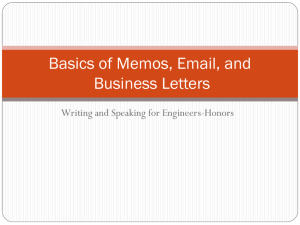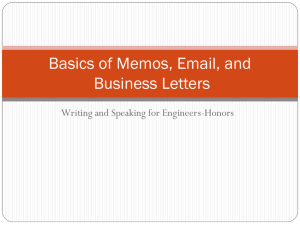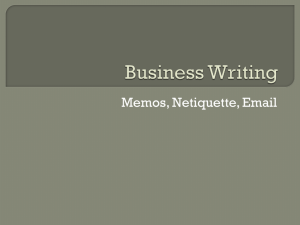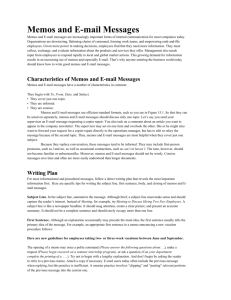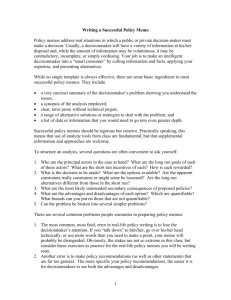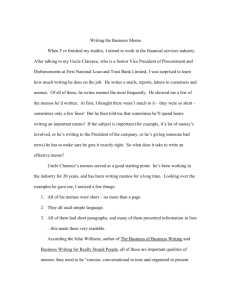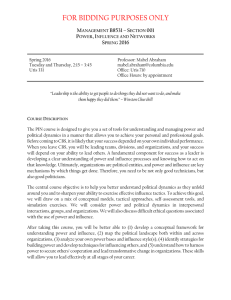Memos - Matt King
advertisement
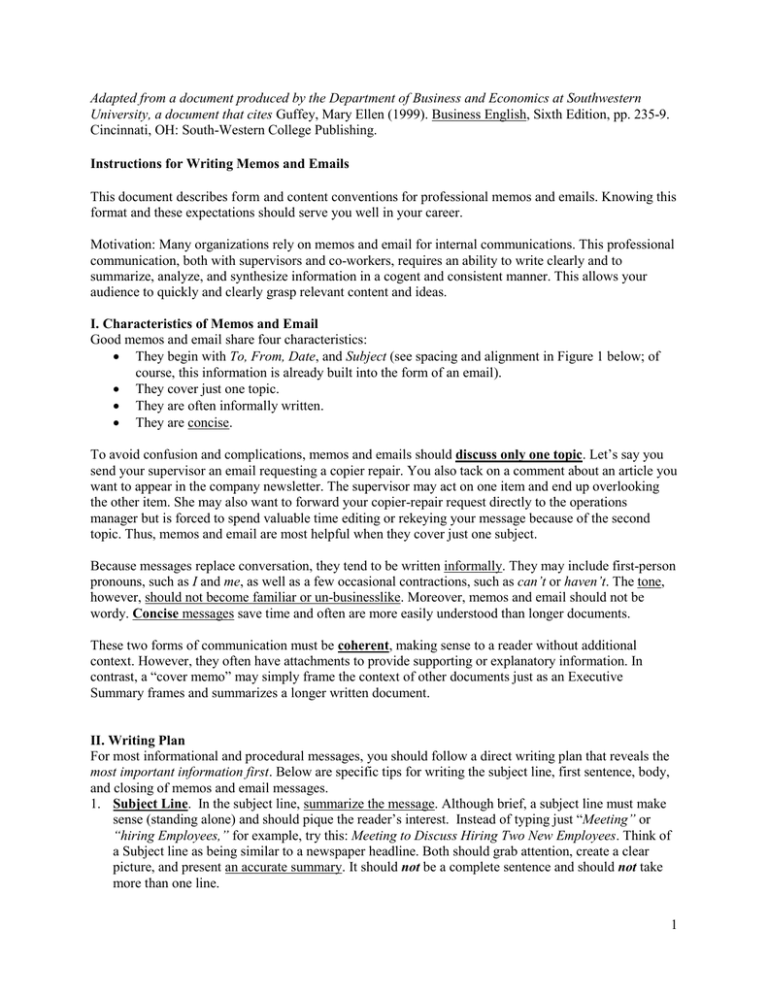
Adapted from a document produced by the Department of Business and Economics at Southwestern University, a document that cites Guffey, Mary Ellen (1999). Business English, Sixth Edition, pp. 235-9. Cincinnati, OH: South-Western College Publishing. Instructions for Writing Memos and Emails This document describes form and content conventions for professional memos and emails. Knowing this format and these expectations should serve you well in your career. Motivation: Many organizations rely on memos and email for internal communications. This professional communication, both with supervisors and co-workers, requires an ability to write clearly and to summarize, analyze, and synthesize information in a cogent and consistent manner. This allows your audience to quickly and clearly grasp relevant content and ideas. I. Characteristics of Memos and Email Good memos and email share four characteristics: They begin with To, From, Date, and Subject (see spacing and alignment in Figure 1 below; of course, this information is already built into the form of an email). They cover just one topic. They are often informally written. They are concise. To avoid confusion and complications, memos and emails should discuss only one topic. Let’s say you send your supervisor an email requesting a copier repair. You also tack on a comment about an article you want to appear in the company newsletter. The supervisor may act on one item and end up overlooking the other item. She may also want to forward your copier-repair request directly to the operations manager but is forced to spend valuable time editing or rekeying your message because of the second topic. Thus, memos and email are most helpful when they cover just one subject. Because messages replace conversation, they tend to be written informally. They may include first-person pronouns, such as I and me, as well as a few occasional contractions, such as can’t or haven’t. The tone, however, should not become familiar or un-businesslike. Moreover, memos and email should not be wordy. Concise messages save time and often are more easily understood than longer documents. These two forms of communication must be coherent, making sense to a reader without additional context. However, they often have attachments to provide supporting or explanatory information. In contrast, a “cover memo” may simply frame the context of other documents just as an Executive Summary frames and summarizes a longer written document. II. Writing Plan For most informational and procedural messages, you should follow a direct writing plan that reveals the most important information first. Below are specific tips for writing the subject line, first sentence, body, and closing of memos and email messages. 1. Subject Line. In the subject line, summarize the message. Although brief, a subject line must make sense (standing alone) and should pique the reader’s interest. Instead of typing just “Meeting” or “hiring Employees,” for example, try this: Meeting to Discuss Hiring Two New Employees. Think of a Subject line as being similar to a newspaper headline. Both should grab attention, create a clear picture, and present an accurate summary. It should not be a complete sentence and should not take more than one line. 1 2. First Sentence. Although an explanation occasionally may precede the main idea, the first sentence typically tells or states the main idea of the message. For example, an appropriate first sentence in a memo announcing a new vacation procedure would be: (This memo contains… or) Here are the new guidelines for employees taking two- or three-week vacations between June and September. The opening of a memo may also issue a polite command (Please answer the following questions about…), make a request (Please begin research on a summer internship program), or ask a question (Can your department complete the printing of a…). Try not to begin with a lengthy explanation, and don’t begin by asking the reader to refer to a previous memo (attach a copy if necessary). Email users often include the previous message when replying, but this practice is inefficient. A smarter practice involves “cutting” and “pasting” relevant portions of the previous message into the current one. 3. Body of Message. Provide details of the message in the body of the message. If you are asking for information, arrange your questions in a logical order. If you are providing information, group similar information together. Think about using headings in bold print or underlining, such as you see in this memo’s paragraphs. They enhance readability by helping readers quickly understand, locate, or reference information. You can also improve the readability of any message through consistency. Compare the two sets of instructions that follow: a. Hard to Read: The instructions for operating our copy machine include inserting your meter in the slot, loading paper in the upper tray, and then copies are fed through the feed chute. b. Improved: Here are the instructions for using the copy machine: Insert your meter in the slot. Load paper in the upper tray. Feed copies through the chute. Notice that all the items in the preceding bulleted list are parallel in construction. That means that the items in the list are grammatically the same: they begin with a verb and end with a prepositional phase. Items on another list might begin with a noun or a verb. This kind of balanced writing helps readers anticipate and understand information more readily. Furthermore, the formatting is consistent. In this case, each example begins with a letter and each item in the improved list begins with a bullet. Lists can be numbered too. The spacing remains consistent between lists, as well as throughout sections, sub-headings, and paragraphs (notice that memo paragraphs are not indented, paragraphs are single spaced, and paragraphs are separated by double space). Consistency improves readability. 4. Closing a Memo or Email. Memos and email messages frequently end with a a. request for action, b. summary of the message, or c. closing thought. If action on the part of the reader is sought, be sure to spell out that action clearly. A vague request such as Drop by to see this customer sometime is ineffective because the reader may not understand exactly what is to be done. A better request might be worded as follows: Please make an appointment to see Rebecca Johnson before June 2 when she will be leaving. Notice that an end or due date is given (June 2). This technique, particularly when coupled with a valid reason, is effective in prompting people to act. 2 Another way to close an internal message is by summarizing its major points. A closing summary is helpful if the message is complicated. If no action request is made and if a closing summary is unnecessary, the writer may prefer to end the memo with a simple closing thought, such as: I’ll appreciate your assistance. What do you think of this proposal? Or Call me if I may answer questions. Avoid tired, mechanical phrases such as Don’t hesitate to call on me, or Thank you for your cooperation. If you wish to express these thoughts, find a fresh way to say them. III. Special Tips for Sending Email Messages Keep lines, paragraphs, and messages short. Try to keep your paragraphs no longer than eight lines and your message short. If it requires more than three screens, consider sending a hard copy. Care about correctness. People are judged by their writing, and errors suggest a lack of professionalism. Read and edit any message before hitting the “Send” button! Avoid sensitive messages. Do not send any message that you would not want available to your boss or co-workers. If a message upsets you, give yourself a cooling-off period before answering that message. Figure 1 To: Michelle Young, Legal Services Dept. From: Rasheed Polk, Human Resources Dept. Date: May 14, 20xx Subject: Change in Job-Advertising Procedure Effective today, all advertisements for departmental job openings should be routed through the Human Resources Department. A major problem resulted from the change in hiring procedures implemented last month. Each department has been placing newspaper advertisements for new-hires individually, when all such requests should be centralized in this office. To process applications more efficiently, please follow this procedure: 1. Write an advertisement for a position in your department. 2. Let Human Resources place the ad in an appropriate newspaper. 3. Pick up applicant folders from Human Resources the day following the closing date provided in the ad. Following these guidelines will save you work and will also enable Human Resources to help you fill your opening more quickly. Call Ann Edmonds at Ext. 351 if you have questions about this procedure. 3
